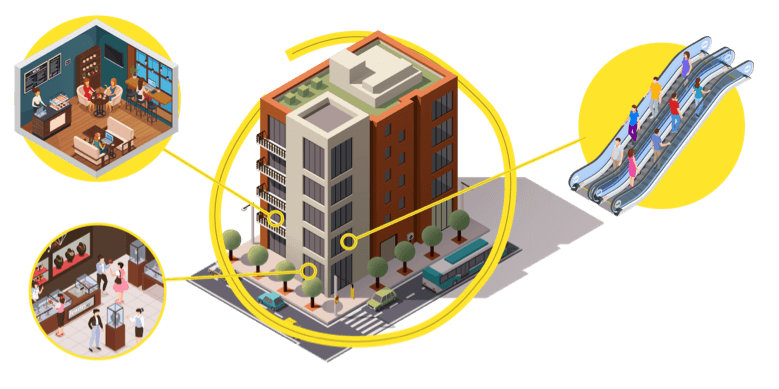Our retail proposition in Afflecks trades very differently from our core retail proposition and we did not fully understand this until we installed the HoxtonAi solution.
Background
Bruntwood is a leading UK property company, with assets spanning work, leisure, retail and living.
Gareth Wilkins is the Area Retail Manager, with oversight of the Afflecks retail asset. An iconic presence in the trendy Northern Quarter of Manchester, Afflecks prides itself on its independent retail brands to promote a creative, buzzy scene.
The Afflecks Team are tasked with maintaining great relationships with their licence holder , making sure visitors get the best experience and ensuring the operations of the building drive value. Furthermore, Afflecks is a hotbed of innovation not just for its visitors, but in the leasing models available to licence holders, with flexible licence contracts and on-site services.
Managing a site such as Afflecks is complex, establishing trust and aligning with prospective and existing tenants is a crucial part of operations. It can be challenging: a jigsaw puzzle of managing tenant mix and ensuring the right prospective tenant fit. A key part of the process is establishing trust with retailers, working together for a win-win partnership.

The Data Gap
Gareth and his team had been relying on gut-feel, and limited and historic data to assess site trends, for example that things were generally busier on a particular day, or people stayed longer on certain days. This posed problems, as it’s difficult to anchor tenant conversations on gut feel assessments.
You can’t manage what you don’t measure, and Gareth felt that two hard metrics would help: how many people visited (foot traffic) and whether people stayed to make the building full (occupancy). Importantly, each licence holder had their own business needs, so understanding these metrics in detail, localised to their area of the asset would help them speak the same language.
We wanted to make data-driven decisions based on real data rather than basing decisions on information that couldn't be verified.
How to measure it?
With Afflecks’ complex layout, over several floors and with many sections, any system needed to be flexible and easy to scale throughout the site as the need arose, without complex installation processes and upfront costs.
The thermal cameras and beam counters installed in the past had provided some trend data, but the basic trends weren’t granular enough to inform discussions, and there was some scepticism of the accuracy amongst the local team. The feeling was that data accuracy was key as it underpinned such important operational decisions, and, without trust, those decisions would default back to ‘feel’. Furthermore, they did not provide site occupancy data. This was important to Gareth, because high footfall but low occupancy may suggest that visitors are ‘passing through’ and not staying to shop.

Deploying HoxtonAi: Simplicity itself
Hoxton Ai provided a low-risk path to begin this journey. Gareth initially trialled four devices to test the ease of deployment and efficacy of the system.
The devices were self-install, removing the time and cost of setup. At first Gareth covered the main entrances to gain an immediate measure of visitor occupancy within the site, split by hour and day. Within this occupancy data were more granular figures such as ins, outs and flows.
When the legacy counting solution failed, rather than exchange it for a similar system, we saw it as an opportunity to change the system to something more meaningful.
Within a matter of hours, Gareth could log in to the HoxtonAi Control Room, to monitor the sensor health, positioning, configuration and of course access the key datapoints he needed. With the User Management control, he could also choose which parts of the Control Room and data to share with his team - for example full access to data could be shared with his team, or specific localised measurements could be shared with a login for tenants themselves.
Impact
The impact was immediate, transforming and refining their assumptions about behaviours in the site. Saturdays were 129% as busy vs non-Saturday average in terms of traffic. Occupancy (rather than traffic) peaks at around 2pm every day, and dwell times were revealed to average around the 24 minute mark, with substantial changes throughout the week.The more granular detail on directional flow revealed behaviour patterns that weren’t known before - which entrances were used as entrances or exits, and at which times of day.
The dashboard is intuitive and inspires you to click away and dig into the data.
To go a step further, Gareth increased the granularity across the site by adding more coverage - breaking it into floors and sections - so that separate occupancy and flow could be observed in a way that was more meaningful for the respective licence holders. The process was the same: receive the devices, set them up quickly and start making decisions.
Gareth now has localised, transparent, data-driven dialogue with his licence holders and can make changes based on the data, and subsequently measure the impact on footfall and occupancy.
Looking ahead, having this information will allow Gareth to consider the impact of opening earlier or closing later.

From the licence holder’s point of view, they can now see and react to the behaviours of their surrounding visitors, based on data rather than feel.Overall, for all stakeholders, the site can be treated as a unique asset with its own characteristics by both the owner and the tenants, helping both parties achieve their aims.
Summary
Managing mixed use retail assets is complex, and there are many variables driving outcomes. The Bruntwood partnership with HoxtonAi has enabled them to isolate and explain what’s driving performance, and drive trust and a win-win approach to tenant and landlord relationships.

The future
As a fast moving technology business, HoxtonAi regularly releases new capabilities that Bruntwood is able to trial, assess and quickly roll out if the RoI is clear for them. Future capabilities include passing traffic measurement, integration with buildings control systems and cross-asset performance measurement. This ensures that whilst it’s easy to get started with HoxtonAi, it is a long-term investment in technology strategy and business optimisation.
Furthermore, as the data collects its value increases, exposing seasonal trends to inform long-term marketing initiatives, including business portfolio and tenant strategy itself.
HoxtonAi
HoxtonAi is a technology company that delivers the easiest and most impactful traffic, occupancy and conversion data to forward-thinking property companies. We offer simple trial packages to quickly assess RoI and business impact of our solution, and support customers globally.
Recent Articles
How real-time footfall data helped a Telco Franchisee drive a 20% increase in revenue
Duncan Mann | Oct 2024
Background: the importance of sales conversion rate
Read moreCase Study: How fashion retailer GOOD uses the HoxtonAi Retail Report to improve accountability and increase conversion across their stores.
Owen | Jun 2023
“The retail report has been a game-changer. Each week, we discuss the footfall and conversion ...
Read moreOn the accuracy of retail footfall counters
Owen | May 2023
In retail, footfall-related metrics have become cornerstone data points used to track various ...
Read moreThe OKR goal setting framework: how to drive success in retail
Owen | Apr 2023
At HoxtonAi, we speak to hundreds of retailers about their store management, data requirements and ...
Read moreHow combining different types of footfall data can build a digital view of physical stores
Owen | Apr 2023
One of the biggest differences between optimization in online and physical retail spaces is the ...
Read moreWhy footfall isn't the end-all. What to do about the retail data gap.
Owen | Apr 2023
In our experience, we’ve found that most retailers are familiar with the idea of monitoring ...
Read moreThe Main Challenges for Retailers in Fully Leveraging Footfall Data
Owen | Mar 2023
In today's digital age, data has become a valuable asset for businesses looking to optimize their ...
Read moreWhat We Talk About When We Talk About Retail Footfall
Owen | Mar 2023
The soft side of cold, hard data We’ve released content on the ‘hard’ aspects of using data to ...
Read moreTop 6 Essential KPIs & Metrics in Retail
Owen | Mar 2023
As retail technology has evolved, we have found better ways to measure, track and compare ...
Read moreWhat is Conversion in Retail? And How to Measure it in a Physical Store?
Owen | Mar 2023
What is a conversion rate? A conversion rate is typically considered to be the percentage of people ...
Read moreHow to use Footfall Analytics to Improve Store Performance
Duncan Mann | Mar 2023
Before we get started, for a quick reminder of what 'people count' and 'footfall' mean, check out ...
Read moreWhat We've Found Analysing Footfall Data in Retail
Duncan Mann | Mar 2023
5 Trends We've Noticed... "At HoxtonAi, we work with customers to ensure their data is high ...
Read moreClosing the data gap between online and physical retailing
Owen | Mar 2023
As shoppers continue to return to the high street post-pandemic, physical stores need to catch up ...
Read moreAn Introduction to People Counting in Retail
Owen | Mar 2023
What is people counting? Simply put, people counting is the act of counting the number of people ...
Read moreCase Study: How Center Parcs Use Occupancy Data To Drive Better Guest Experiences.
Duncan Mann | Aug 2022
We initially trialled the HoxtonAi solution on a small scale to ‘kick the tyres’ and see if it’s a ...
Read more